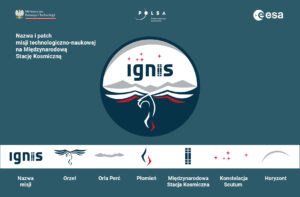The year 2025 will go down in the history of the Polish space sector as a watershed moment. Dr. Sławosz Uznański, a European Space Agency (ESA) project astronaut, will take part in the first Polish technological and scientific mission to the International Space Station (ISS). As part of the Ignis mission, Poland will join the ranks of countries conducting manned space research.
The significance of the Ignis mission
The name “Ignis”, Latin for “fire”, symbolizes Poland’s energy, creativity and ambitions in the field of advanced space technologies. The project, funded by the Ministry of Development and Technology and carried out with the support of ESA and Axiom Space, involves conducting thirteen experiments in the fields of technology, biology, medicine and psychology. Research in microgravity conditions is expected to open up new opportunities for Polish scientists and increase Poland’s international competitiveness.
The mission’s official patch, presented by Dr. Uznański, features a red-and-white eagle – Poland’s national symbol – whose tail is arranged in the shape of a flame. The eagle’s outspread wings resemble the contours of the Eagle Perch mountain range in the Tatra Mountains, and the stars above the mission’s name form the constellation of Sobieski’s Shield, paying tribute to astronomer John Hevelius. The second letter “i” in the word “Ignis” is stylised as the panels of the International Space Station.

Preparation and crew
Dr. Uznański will be the second Pole in space and the first to visit the ISS. His flight will take place as part of the Ax-4 mission, carried on the SpaceX Crew Dragon spacecraft launched by a Falcon 9 rocket. Uznański will join an international crew led by Peggy Whitson, which also includes mission specialists from India and Hungary. The astronaut is currently undergoing intensive training at ESA, NASA and Axiom Space centers.
Participation in the mission is the result of an agreement between the Ministry of Development and Technology and ESA. The crew will include:
- Peggy Whitson (USA) – mission commander,
- Slawosz Uznański (Poland/ESA) – mission specialist,
- Shubhanshu Shukla (India) – mission pilot,
- Tibor Kapu (Hungary) – mission specialist.
Preparations for the mission began in August 2024. The training program includes emergency simulations, medical training and tests related to operating the Dragon capsule, as well as acquiring certifications, such as a ham radio license that allows for communications with Earth from aboard the ISS.
The Ax-4 mission is scheduled to launch from the Kennedy Space Center in Florida using SpaceX’s Falcon 9 rocket, which will carry the Dragon crew capsule. The mission will last about 14 days, during which astronauts will conduct experiments in microgravity conditions, focusing on projects prepared by Polish scientists under the guidance of ESA and POLSA.

A breakthrough for Poland
Polish research conducted in space opens up new prospects for international cooperation and strengthens Poland’s position as an active partner in the European Space Agency.
Source: POLSA, DziennikNaukowy.pl, @Astro_slawosz







